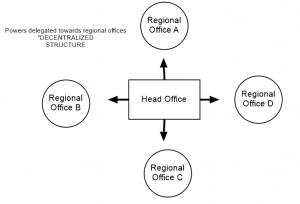Whats is meant by Centralization and Decentralization
Introduction:
In the realm of organizational design, the concepts of centralization and decentralization play a crucial role in shaping how companies structure their operations, decision-making processes, and overall management. Centralization refers to the concentration of authority, decision-making power, and control at the top levels of an organization. In contrast, decentralization involves the distribution of authority and decision-making responsibilities across various levels and departments within the organization. This article aims to provide a comprehensive understanding of centralization and decentralization, their characteristics, advantages, disadvantages, and real-life examples. By exploring these concepts, we can gain insights into how they influence organizational effectiveness, efficiency, and overall performance.
Centralization:
Centralization refers to the concentration of decision-making authority and control at the higher levels of an organization’s hierarchy. In a centralized structure, power is typically vested in a single person or a small group of individuals at the top, such as the CEO, board of directors, or senior executives. This central authority makes key decisions, establishes policies, and directs the activities of the entire organization.
Characteristics:
The key characteristics of centralization include:
Concentration of Power:
Decision-making power is concentrated at the top levels of the organization.
Hierarchical Structure:
Centralization often coincides with a hierarchical organization, where authority flows downward from the top to lower levels.
Standardized Policies:
Centralized organizations tend to have consistent and standardized policies, procedures, and practices across the entire entity.
Limited Autonomy:
Lower-level employees have limited autonomy and decision-making power, as they are expected to follow directives from the central authority.
Centralized Information Flow:
Information and data typically flow upward and are consolidated at the top levels for analysis and decision-making.
Advantages of Centralization:
The advantages of centralization include:
Efficiency:
Centralization can lead to increased efficiency as decisions are made by specialized individuals or groups, leveraging their expertise and experience.
Consistency:
With centralized decision-making, policies, and procedures are applied consistently across the organization, leading to uniformity and standardization.
Strategic Alignment:
Centralized structures ensure that decisions align with the organization’s strategic goals and objectives, as they are made by individuals with a comprehensive view.
Economies of Scale:
Centralization can result in economies of scale, as resources are managed and allocated centrally, potentially reducing costs and optimizing their utilization.
Control and Coordination:
Centralization facilitates better control and coordination of activities, ensuring that efforts are aligned and resources are used efficiently.
Disadvantages of Centralization:
The disadvantages of centralization include:
Slow Decision-Making:
The process of making decisions and disseminating them through the hierarchy can be time-consuming, leading to delays in implementation.
Bureaucracy:
Centralization may lead to an increase in bureaucracy, with rigid rules, procedures, and a focus on following established protocols.
Lack of Flexibility:
Centralized structures may struggle to adapt quickly to changing market conditions or customer needs, as decisions need to be approved by higher authorities.
Limited Innovation:
The concentration of power at the top can hinder innovation, as ideas and initiatives may not emerge or be implemented as quickly.
Overburdened Top Management:
Centralized structures can result in top management being overburdened with decision-making responsibilities, potentially affecting their ability to focus on strategic initiatives.
Real-Life Example:
Example: Walmart
Walmart, the multinational retail corporation, is known for its centralized organizational structure. The company’s headquarters in Bentonville, Arkansas, makes key decisions regarding merchandising, pricing, and marketing strategies. These decisions are then implemented consistently across its vast network of stores worldwide. This centralized approach has contributed to Walmart’s success in maintaining uniformity, efficiency, and cost control.
Decentralization:
Decentralization involves the distribution of decision-making authority and responsibility across various levels and departments within an organization. In a decentralized structure, power is delegated from the top levels to lower levels, empowering individuals or teams to make decisions within their areas of expertise or geographic regions.
Characteristics:
The key characteristics of decentralization include:
Distributed Power:
Decision-making power is shared among individuals or teams at different levels and departments.
Autonomy:
Lower-level employees and managers have greater autonomy and discretion in making decisions.
Localized Decision-Making:
Decisions are often made at the local or departmental level, considering specific circumstances and needs.
Flexible Policies:
Decentralized organizations may have more flexible and adaptable policies to accommodate varying conditions.
Information Flow:
Information and data are dispersed throughout the organization, allowing for localized analysis and decision-making.
Advantages of Decentralization:
The advantages of decentralization include:
Agility and Flexibility:
Decentralization enables organizations to adapt quickly to local market conditions, customer needs, and changing circumstances.
Empowered Employees:
Decentralized structures empower employees by giving them a sense of ownership and involvement in decision-making, leading to higher job satisfaction and motivation.
Improved Customer Responsiveness:
With decision-making authority closer to the customer, organizations can respond more swiftly to customer needs and feedback.
Enhanced Innovation:
Decentralization encourages innovation by allowing ideas and initiatives to emerge from various levels and departments.
Efficient Use of Top Management’s Time:
Decentralization frees up top management’s time, allowing them to focus on strategic planning and long-term goals.
Disadvantages of Decentralization:
The disadvantages of decentralization include:
Inconsistent Policies:
Different departments or regions may develop their own policies and procedures, leading to inconsistencies and a lack of standardization.
Coordination Challenges:
Ensuring coordination and alignment of activities across departments or regions can be challenging, potentially affecting overall organizational efficiency.
Limited Strategic Alignment:
Decisions made at lower levels may not always align with the organization’s strategic objectives, potentially leading to conflicts or deviations from long-term goals.
Increased Costs:
Decentralization may result in higher costs due to the need for additional resources, training, and infrastructure to support decision-making at multiple levels.
Duplication of Efforts:
Decentralized structures may experience duplication of efforts or resources, as each department or region operates independently.
Example: Amazon
Amazon, the e-commerce giant, exemplifies a decentralized organizational structure. The company’s headquarters in Seattle sets the overall strategic direction, but individual business units, such as Amazon Web Services (AWS), Amazon Prime, and Amazon Fresh, have significant autonomy in decision-making. This decentralized approach allows Amazon to adapt quickly to market changes, innovate rapidly, and provide localized services to customers worldwide.
Conclusion:
In conclusion, centralization and decentralization represent two contrasting approaches to organizational design, each with its own set of advantages and disadvantages. Centralization offers efficiency, consistency, and control, while decentralization promotes agility, flexibility, and employee empowerment. The choice between centralization and decentralization depends on the organization’s goals, industry, and cultural preferences. By understanding the implications of each concept, businesses can design structures that optimize decision-making, enhance performance, and align with their strategic objectives. Real-life examples, such as Walmart and Amazon, showcase how these concepts are applied in practice, influencing organizational effectiveness and success.
SUMMARY:
Centralization vs Decentralization
An important aspect of organization structure is the extent of power ratio between head office and regional office. If head office has retained powers of major decisions, it is known as centralized structure. If powers are delegated to regional managers to make their own decision based on local requirements, then it is known as de centralized structure


